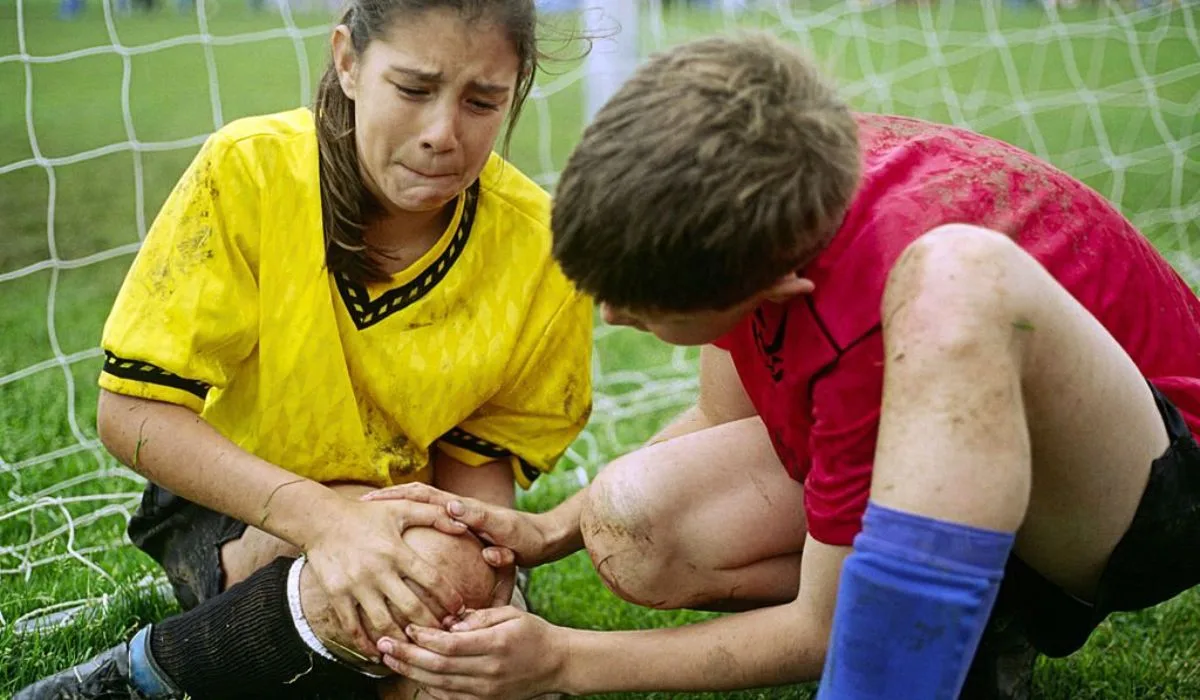Although the rates of overall injuries and severity are high in much older football players, say in high school or college, we see more injuries in young players. Studies on young athletes have revealed that they are more susceptible to concussions and take longer to recover compared to older athletes.
This is considering their ongoing growth spurts, slower reaction times, and still developing motor skills. In this article, we will explore the major injuries in youth football and ways to tackle them.
Common Football Injuries And Tips To Tackle Them

Compared to other sports, football has a higher incidence of more serious and catastrophic injuries. Most football-related injuries occur in the musculoskeletal system due to overexertion, poor form, neuromuscular factors, and unsafe tackling techniques. Here are some of the common injuries in youth football and tips to tackle them.
Also Check: Playground Injuries: First Aid And Recovery Tips For Ensuring Safety
💠 Head And Neck Injuries
Concussions are the most common injuries seen in young football players. It can cause abnormalities in cognition, vision, and balance in the players. Headache, dizziness, confusion, loss of balance, and light sensitivity are the typical symptoms associated with it.
Additionally, we should be aware of the possibility of second impact syndrome, a brain injury that results from a player returning to play too soon after suffering a concussion and can cause long-term brain damage. Thus, parents and coaches should promptly recognize symptoms and remove them from the game until they recover completely.
At present, we don’t have any helmets or gadgets to prevent concussions; however, avoiding blows to defenseless players, practicing proper tackling techniques, and strengthening neck muscles can be beneficial. Parents should make sure that their kids know the rules of the game, insist they stick to them no matter what, and get them a coach who emphasizes proper techniques.
💠 Shoulder Injuries
Despite using shoulder pads, shoulder injuries can occur in football players. The common shoulder injuries seen among the players include broken collarbones, rotator cuff contusions, ACJ separations, and shoulder instability.
In the game, the players who play in the quarterback or defensive back positions are at higher risk of injuring their shoulder than the others. While the lineman suffers from rotator cuff contusions and posterior shoulder instability, However, we must insist the kids use shoulder pads. Choose pads with thick padding and a hard plastic shell.
💠 Knee Injuries
Football players of all ages are prone to knee injuries. Players in the running back and linebacker positions are more likely to sustain a knee injury. Likewise, linemen are at higher risk of MCL injuries, and offensive players are at higher risk of ACL injuries. These injuries can adversely affect their long-term involvement in the sport and performance. Wearing a knee pad can prevent injuries from the game.
💠 Ankle Injuries
Ankle sprains are another frequent injury seen among players. Fortunately, these can be treated by nonoperative means of rest, ice, compression, and physical therapy.
💠 Overuse Injuries
Overuse injuries are sports-related microtrauma brought on by overtraining or repeatedly using the same body parts. They can cause damage to the bones, muscles, ligaments, or tendons of the knees, ankles, back, and elbows of an individual. Overuse injuries like Achilles tendinitis, jumper’s knee, and shin splints are also common in football.
Overuse injuries can be tackled by:
- Cross-training: As an increased volume of one specific movement can lead to overuse injuries, we should encourage the kids to participate in diversified sports training.
- Moderation: Year-round training with no rest can add to the risk of overuse injuries. Therefore, they must get proper rest and should limit their involvement in continuous intensive sessions to reduce injury risk.
- Strengthening programs: Involving strengthening exercises and drills can develop endurance, strength, balance, and coordination in the players. These activities can help improve their performance and safeguard them from overuse injuries.
💠 Heat Injuries
These injuries are a common concern for all young football players, especially during hot and humid conditions. Intense training can cause excessive sweating that depletes salt and water from the body, resulting in heat exhaustion, dehydration, and heat stroke. These injuries are, in fact, deadly if we don’t attend to them. Thus, we should find cooling, fluid replacements, and immediate medical attention.
Read More: Pediatric Sports Injuries: Diagnosis And Treatment
Other Measures
- Pre-season health evaluation: These can help us identify potential risk factors like musculoskeletal malfunctions, previous injuries, or any other conditions that might put your kid in danger of more serious ailments.
- Ensure a safe environment: Trainers or coaches are supposed to inspect the soccer field surfaces and ensure safe field conditions before the game.
- First aid facility: Being aware of first aid and having easy access to medical care can help in emergencies.
End Note
In youth football, it is hard to be entirely free from the risk of injuries. However, proper knowledge of tackling and blocking techniques, adherence to the rules of the game, wearing protective gear, ensuring a safe playing environment, proper rest, and access to immediate first aid and medical care can minimize injuries and help us tackle the situation.